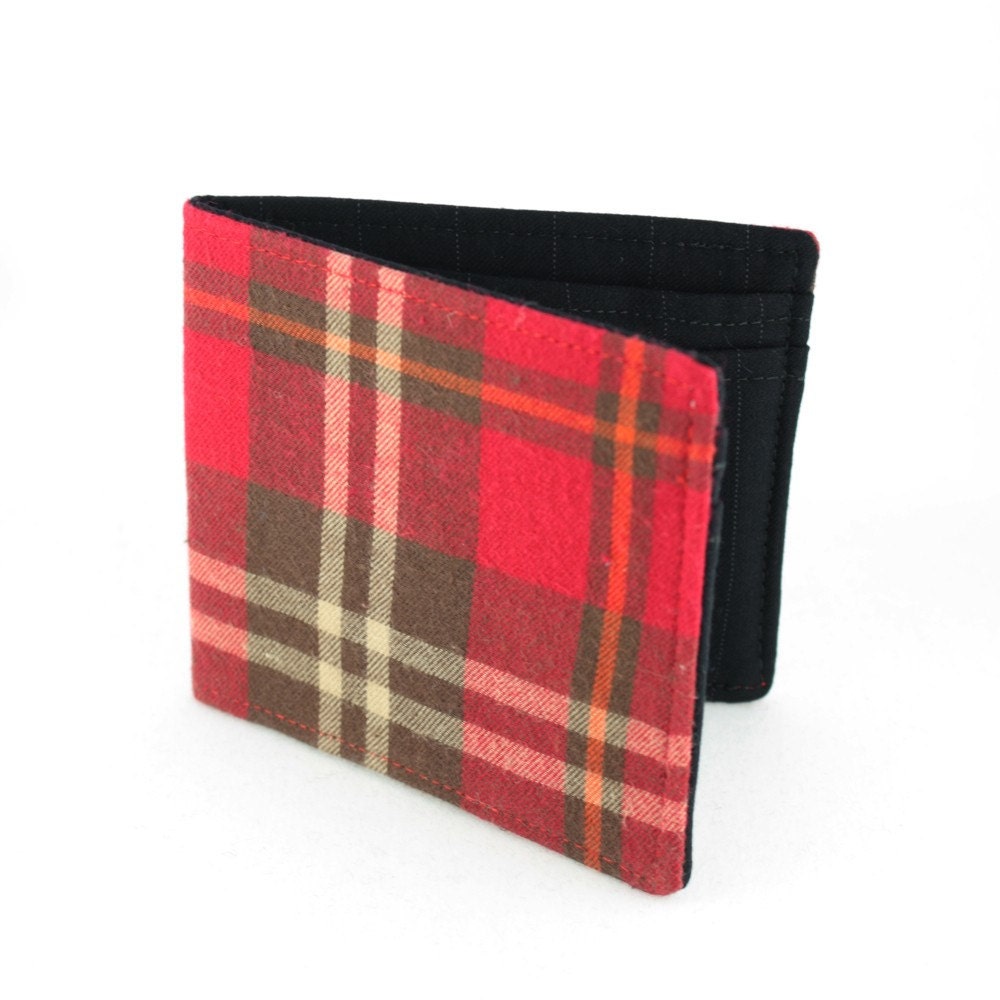Wednesday, October 10, 2012
Make Your Craft Pay
Tuesday, June 14, 2011
"How to be Successful on Etsy" by Prix Prix
FTEC member Laura (Prix Prix) shares her Etsy Success tips with us today! Originally posted on prix prix blog on 6/13/11.
I get regular emails from folks who are just starting out on Etsy and want to know what the secret is to getting attention and sales in their shops. There is certainly no secret- it takes time and lots of work to build up a following. Luckily, there are a bunch of easy changes you can make to your shop, and strategies for promoting it, that will get your shop busy as quickly as possible. I figured out all of this through years of trial and error, and now you can skip repeating my mistakes and get ahead much more quickly.
And now… the secret to selling a zillion of your handmade widgets on Etsy!
Photos
- Awesome photos are vital for getting attention on Etsy. Pretty photos make it into Treasuries (member curated galleries of products), and great Treasuries are featured on Etsy’s front page, getting you tons of visibility. Also, blogs will feature nice photos. Your photos need to be edited in a program like Photoshop, Apple’s iPhoto, Picasa (Google’s free program) or Picnik on Flickr. Increase the contrast and the brightness until the photos pop more. Look through items featured on the front page and in treasuries, and also in catalogs, to get an idea of what types of photos and how much contrast works the best. I really can’t emphasize enough how vital really amazing photos are for having any success selling your beautiful handmade goods on the internet.
- Follow this simple tutorial on brightening photos: http://www.etsy.com/storque/make/how-to-brighten-your-photos-with-paperama-2900/ There is no excuse for blurry, dark, overexposed, or bland looking photos when it is this easy to fix them! This is the single most important thing you can do for your shop today.
- In the longer term, getting a dedicated setup for photographing products is essential. A bright sunny corner with no distracting background items, for example, or even a large foamboard panel that you can set up in the background when you’re photographing. Avoid a busy background – the focus should be on your products. Different shops have their own style or background for photos. I use a white background, others might use wood or a textured background. Some use simple, attractively arranged props to enhance their photos. Here is my inspiration board for great product photography: http://pinterest.com/prixprix/product-photography/
- Keep in mind that for getting featured on Etsy, the product should look fantastic in the large main thumbnail version (when you view the shop in “gallery” mode). Play with interesting angles, pay attention to cropping (I like to crop all of my photos to be square – they seem to look best that way), make sure your colors and your lights/darks pop.
- If you have something meant to be worn or carried, think about working with a photographer friend to get some great, well lit model shots.
Descriptions & Titles
- Avoid super short descriptions, and break up text into multiple short paragraphs. Write in descriptive sentences. Talk about who would use your product and how. Are they perfect for busy moms on the go? People also like to hear the story of how it’s made. On Etsy, people are really buying the photo and the story of the item.
- Think about coming up with interesting product names or styles.
- Use lots of descriptive words in the title and the text, especially colors, patterns, seasonal references, styles/trends (eg nautical, geometric, neon, etc), and seasonal things (I like to mention that my items are great Father’s Day gifts, for example). People making Treasuries will search for these terms to fit with their themes, and you want your product to come up in those searches if it would fit.
- Always include the dimensions of the product. It’s a good idea to state the dimensions in both English and Metric for your customers abroad. Also include descriptive measurements, eg. if it’s a computer bag, what’s the biggest laptop that will fit?
- Be consistent with capitalization in your product titles. I prefer titles to be first-letters-capitalized, personally.
- Move a few important items from the Shop Policies to the bottom of the item description. Very few people read the policies. Mention in the item description if you take custom orders. Mention how the item is packaged and if it can be gift-wrapped. Tell people if it comes in other colors.
- Example: Moop has great, clear descriptions to give you a sense of what types of info to include: http://www.etsy.com/listing/69699738/the-paperback-in-red-waxed-canvas (I want that bag!)
- See if you can find a graphic designer friend to help create a great shop banner that includes both your shop name and an image of your products. I’d also use a great product photo for your shop avatar.
Strategy
- Renew an item listing or list a new item at least once a day, at a time when people are generally awake. In general, don’t relist several at once. Listings get buried in Etsy searches very quickly.
- Be social! Add people to your “Circle” on Etsy. Add their items and shops as favorites. Create some lovely Treasuries of your own with a theme & feature other peoples’ items.
- Join an active Etsy team. There are lots of active teams based on artistic medium, location, lifestyle, and more, so it shouldn’t be too hard to find a great one.
- Have excellent customer service. Use PayPal Shipping or Endicia to create shipping labels with tracking, and email the tracking info & a friendly thank-you to the buyer when their item ships. Take responsibility if anything goes wrong, even if it’s entirely the fault of the Post Office. People really appreciate it and will be on your side (and maybe will even tell their friends about your shop). Try to respond to emails within a day – the sooner the better. (And if you do sign up for Endicia, please use my referral code- 741192 -in the “promo code” field, and you will give me a free month! Thanks! http://www.endicia.com/)
- Apply to a hip local craft fair. A very large percentage of my Etsy customers first found me at craft fairs. This is a great way to start word-of-mouth buzz about your products!
- After your photos and descriptions are made as awesome as possible, send a friendly email to a blogger who features work like yours. Target only blogs that are a great fit. Here is a fantastic article about how to do this: http://www.modishblog.com/biztips/2008/09/how-to-approach-blogs-and-get-them-to-write-about-you.html Blog features, even on smaller blogs, do a ton to increase traffic to your shop & get you sales. Always send a nice brief thank you to anyone who features you.
Further Reading
Here are some resources that should fill in the rest:
- Get the book Craft, Inc. by Meg Mateo Ilasco.
- Join The Switchboards – Forums for women in creative businesses. Search the archives, so much has already been discussed.
- Sign up for the Etsy Success emails – full of helpful tips for your shop.
- Browse Etsy’s selling tutorials in the Etsy Seller’s Handbook.
OK, that should put you well on the path towards Etsy success and superstardom. Wishing you all the best!
-Laura from Prix-Prix
Monday, March 21, 2011
Tuesday, July 13, 2010
Handmade Guide to Buying Yarn
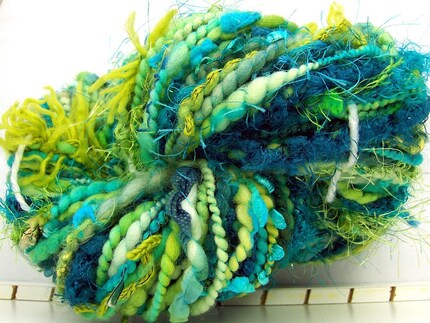
You've picked a pattern and have an image of a beautiful knit piece in your mind. Your needles are ready, and you can't wait for the kids to go to bed so that you can start. The only thing missing to start your new project is the perfect yarn.
Monday, July 5, 2010
Book Review - Deliverying Happiness

As a business owner, I am always looking for new inspirations for my business. When our FTEC member Eleen recommended the book "Delivering Happiness", I was intrigued by its title. We all want to be happy, but what exactly does Tony Hsieh mean by "Delivering Happiness?"
Delivery Happiness started as an informal autobiography, with stories of Tony Hsieh's multiple failed business attempts as a child as a result of big dreams, great concepts, and lack of experience and research. Hsieh's desire to make big money by owning a business was not deterred by his failed attempts, and eventually one of his business ideas (custom buttons) actually succeeded and generated good income for the teenager. From there Hsieh continued to have different businesses. He became a milti-millioanaire after selling LinkExchange (which he co-founded), got involved with Zappos as an adviser and investor, and then eventually became CEO. Within 10 years, Zappos grew from almost no sales to $1 billion in gross merchandise sales, and was eventually acquired by Amazon in 2009 in a deal valued at over $1.2 billion on the day of closing.
Just like many other great success stories, Hsieh's success almost seems too glamorous and too easy -- that is, if you don't read the book Delivering Happiness, in which Hsieh candidly shares his roller coaster ride with the readers. There were ups and downs over the course of 10 years, and it took a lot of courage, passion and wisdom to create an empire.
Half way through the book, just when I was about to start wondering, "ok, so this book is about the background of Hsieh's success story. And what does it have anything to with 'Delivering Happiness'?" the direction of the book suddenly changed.
The book was divided into three sections...
Section I - Profits
Section II - Profits and Passion
Section III - Profits, Passion, and Purpose
These three sections symbolically represent different periods of Hsieh's life. Before his business succeeded, all Hsieh wanted was profits -- "I just wanted a job that paid well and didn't seem like too much work."(p.29) Then, after his success with LinkExchange, the young millionaire realized that money alone couldn't bring him happiness -- "I didn't know exactly what I was going to do, but I knew what I wasn't going to do....I had decided to stop chasing the money, and start chasing the passion."(p.54)
A turning point of Zappos was when Hsieh and Mossler(Fred) decided to make the Zappos brand about the best customer service -- “…in the long run, little things that keep the customer in mind will end up paying huge dividends.”(p.128)This is where “Delivering Happiness” came in --“As we rolled out these additional services, we slowly realized that we were becoming part of a bigger movement. It was no longer just about Zappos. We were helping change the world.”(p.208) Hsieh talked about how Zappos delivers happiness through their unique culture/core values. Not only does Zappos try to make customers happy, it also strives to make the employees and vendors happy.
I had started reading “Delivering Happiness” hoping to learn to make profits, and it was nothing like what I expected -- It was much, much more.
If you are interested in learning more about "Delivering Happiness", check out their website, twitter or facebook page! (I especially love Tony's twitter page among the three)
mollie (aka muyinmolly)
Disclosure: I have received the book free of charge . I am honestly reviewing the products and have not been paid for my endorsement as it pertains to the products received.
Tuesday, May 25, 2010
Reproductions vs. Originals

Wednesday, May 19, 2010
Handmade Guide to Glass
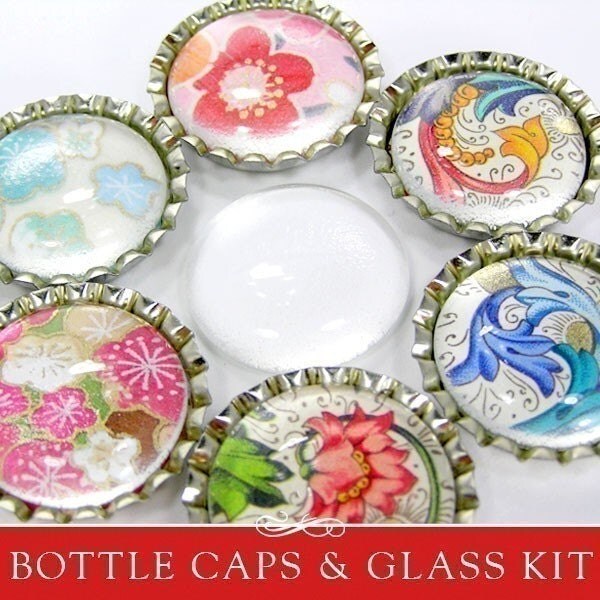
If you’re purchasing clear glass pieces for your creative projects, the two basic types of glass you would encounter are float glass and rolled glass. Most of the economically priced glass available is made overseas in China by large manufacturing companies that produce thousands of glass tiles each day and is made from float glass. Float glass is made by floating molten glass onto molten tin, hence the name. It's a process that imparts some of the metal properties into the glass sheets which can discolor or dull the glass. And while that glass may be hand cut and kiln fired, it’s 99.9% likely the glass isn’t hand cut and kiln fired by the seller. Just because the seller claims the glass is handmade, and I’m sure it is handmade by someone somewhere, that doesn’t mean it’s handmade by them.
Similarly, glass that is stated as “designed” by the seller doesn’t mean the seller made the glass. It just means they placed an order with a manufacturer in China who makes glass tiles to order. It’s a rather deceitful way of not being straightforward about who makes their glass because they want the customer to assume they made the glass themselves. For example, if you place a custom order with me for glass and I cut and fired your glass, would you claim you made the glass? Probably not. You gave me dimensions of the size you wanted and I cut and kiln fired the glass for you. The glass, however, is still handmade. Did you design the glass? If instructing glass to be cut to a 1” square is called “designing” then I suppose you did.
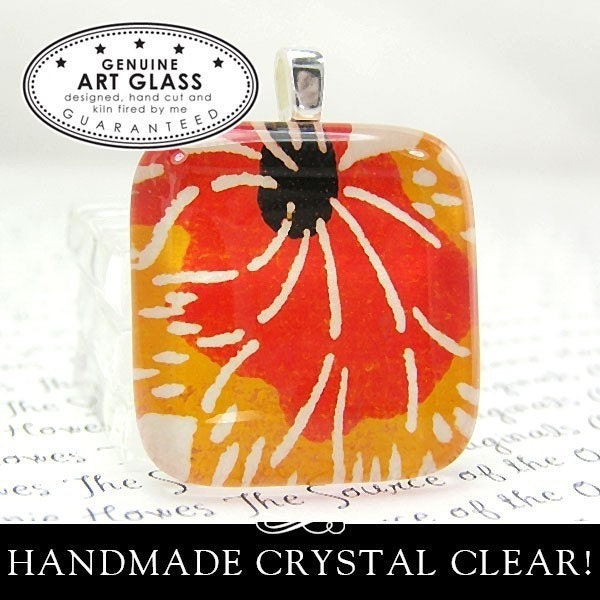
Why should you be concerned with any of this? Because there are obvious visible differences in the glass you’ll most likely receive if you purchase glass not handmade (ie. not hand cut and kiln fired) by the seller (float glass) vs. glass handmade by the seller (rolled glass). If you are spending your time and talents on creating beautiful jewelry or other pieces of art, wouldn't you want to use the most beautiful glass available?
What is the difference between the glass types? There are basically two different glass types available for glass pendants: float glass, and fusible glass. Float glass is typically used for tiling your kitchen or bath and architectural installations. Thin float glass is also used in soldered charms, and the glass you put your photos behind in a picture frame is also float glass. The float glass sold for use in glass pendant making is a low-iron glass. Low iron means the amount of green (iron) in the glass is reduced or removed. I, too, offer this economical glass as an alternative when high quality glass isn't important. While the glass is clear and colorless, it lacks the spectrum of light that you would see in crystals. It’s dull and flat and lifeless. And cheap.
The alternative to dull and lifeless glass is called rolled art glass, which is the type of glass used primarily in glass fusing. This is the good stuff, and not just because I said so. Rolled glass for fusing has such high clarity that it’s very much like crystal in its appearance. It shines, it sparkles and is alive with all spectrum of light. It’s breathtaking by comparison. Each piece is a work of art. Rolled glass is the same type of raw glass used in large fused glass platters, and glass vases, and such. It's art glass and is specifically created for use in fine art pieces.
How can you tell the glass you’re buying is quality art glass handmade by the seller? First, you can ask. I believe most sellers of glass tiles for jewelry and crafting are decent honest people and will give you an honest answer if asked outright about the glass they’re selling. Ask what type of glass it is, if it’s rolled glass (high clarity, used for fusing) or float glass (low clarity, lusterless used for architectural installations). Ask if it’s imported glass, or if they cut and fired the glass themselves on site. I don’t think anyone would be offended by these questions and most glass artists are more than happy to discuss their craft.
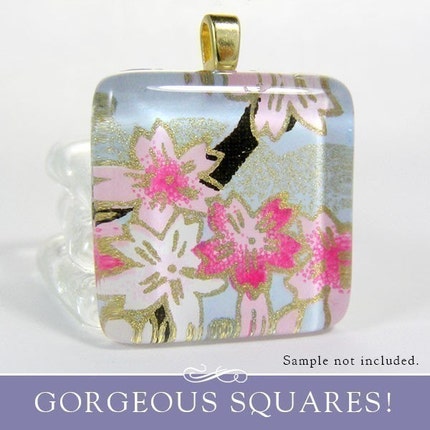
If you still suspect the glass is not handmade by the seller, ask if the artist can custom fire glass to meet your specifications. If they don’t make custom cut glass and only offer specific sizes, they probably are importing their glass and you should continue your search for quality handmade glass elsewhere.
If you have purchased glass and are concerned that it's not the quality of glass it was advertised to be, check to see if the glass is smooth on both sides of the piece. If so, the glass is float glass and was most likely not handmade by the seller.
Support true handmade supplies made by the artist who created the products you're purchasing. Your finished pieces will radiate with life!








